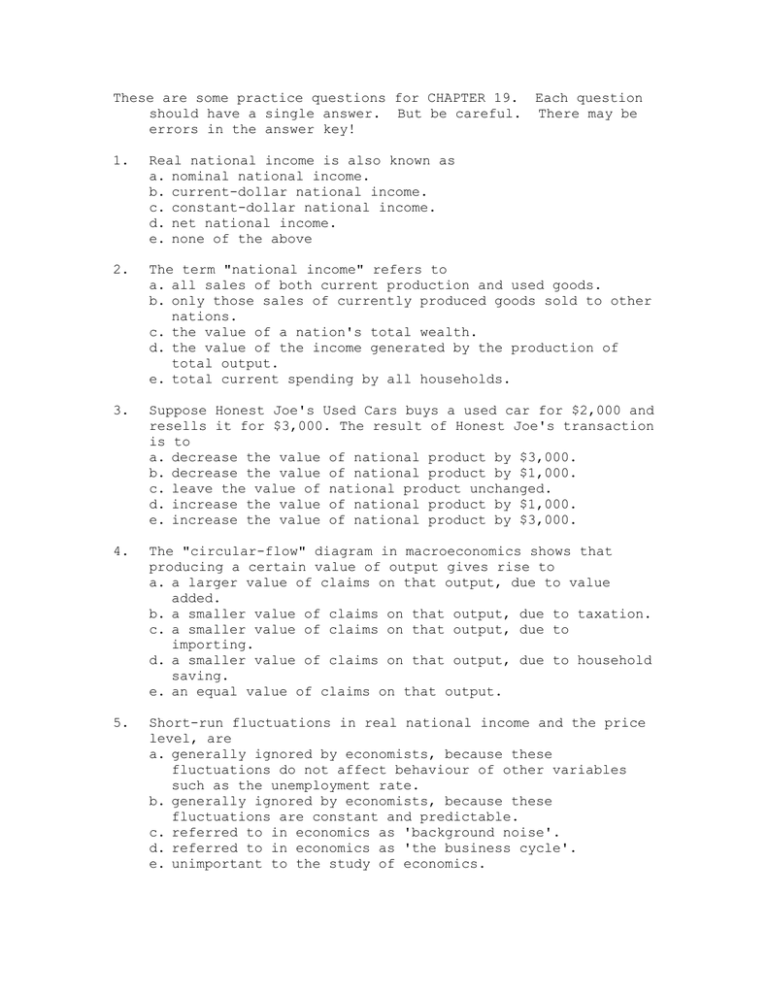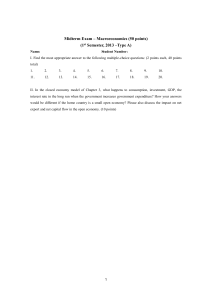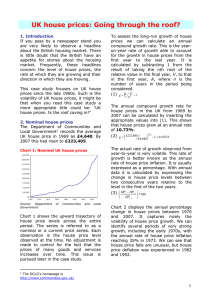Document 12702883
advertisement

These are some practice questions for CHAPTER 19. Each question should have a single answer. But be careful. There may be errors in the answer key! 1. Real national income is also known as a. nominal national income. b. current-dollar national income. c. constant-dollar national income. d. net national income. e. none of the above 2. The term "national income" refers to a. all sales of both current production and used goods. b. only those sales of currently produced goods sold to other nations. c. the value of a nation's total wealth. d. the value of the income generated by the production of total output. e. total current spending by all households. 3. Suppose Honest Joe's Used Cars buys a used car for $2,000 and resells it for $3,000. The result of Honest Joe's transaction is to a. decrease the value of national product by $3,000. b. decrease the value of national product by $1,000. c. leave the value of national product unchanged. d. increase the value of national product by $1,000. e. increase the value of national product by $3,000. 4. The "circular-flow" diagram in macroeconomics shows that producing a certain value of output gives rise to a. a larger value of claims on that output, due to value added. b. a smaller value of claims on that output, due to taxation. c. a smaller value of claims on that output, due to importing. d. a smaller value of claims on that output, due to household saving. e. an equal value of claims on that output. 5. Short-run fluctuations in real national income and the price level, are a. generally ignored by economists, because these fluctuations do not affect behaviour of other variables such as the unemployment rate. b. generally ignored by economists, because these fluctuations are constant and predictable. c. referred to in economics as 'background noise'. d. referred to in economics as 'the business cycle'. e. unimportant to the study of economics. 6. Common usage of the term "recession" defines it as a fall in the real GDP for at least a. one quarter. b. two quarters. c. three quarters. d. one year. e. two years. 7. If a country's labour force is 15 million people, and 1 million are unemployed, the country's unemployment rate is a. 2.5 percent. b. 3.3 percent. c. 4.5 percent. d. 6.7 percent. e. 9.0 percent. 8. Suppose the city of Calgary, Alberta has a population of 900,000 and a labour force of 475,000. Employment is 450,000 and 30,000 workers are unemployed. The unemployment rate is approximately a. 3.3 percent. b. 6.3 percent. c. 6.7 percent. d. 47.2 percent. e. 50.5 percent. 9. Index numbers measure a. a change in absolute prices. b. a change in quantities of commodities sold. c. a change in relative prices. d. an absolute change in some broad average over some particular time span. e. a percentage change in some broad average over some particular time span. 10. If nominal national income increased 10 percent over a certain period of time while real national income increased by 20 percent then a. everybody in the economy became worse off. b. inflation has occurred during this time period. c. the labour force increased by 10 percent. d. the price level has declined by about 10 percent. e. the price level has increased by approximately 10 percent. 11. If the expected rate of inflation is 3 percent, and contract negotiators agree that real wages should rise by 5 percent, the two sides will agree to an increase in money wages of a. 2 percent. b. 3 percent. c. 5 percent. d. 8 percent. e. 15 percent. 12. If the Consumer Price Index changes from 120 in year one to 144 in year two, the rate of inflation in the intervening year is a. 10 percent. b. 12.5 percent. c. 20 percent. d. 25 percent. e. 30 percent. 13. Consider the following information regarding the expenditure behaviour of 10-year olds in 1990 and 1999. Expenditure Behaviour in 1990 ********************************************************************* Quantity Expenditure Total Price per month per month Expenditure ********************************************************************* Comics $0.50 5 $2.50 Chocolate bars $1.00 4 $4.00 Popsicles $0.15 10 $1.50 TOTAL $8.00 ********************************************************************* Expenditure Behaviour in 1999 ********************************************************************* Quantity Expenditure Total Price per month per month Expenditure ********************************************************************* Comics $0.65 5 $3.25 Chocolate bars $1.20 4 $4.80 Popsicles $0.20 10 $2.00 TOTAL $10.05 ********************************************************************* Using 1990 as the base year, what is the value of this consumer price index for 10-year olds in 1999? a. 1.256 b. 0.796 c. 125.625 d. 100.125 14. If the price index is P1 in a given year and P2 in the next year, the inflation rate is calculated as a. (P2 - P1) x 100 b. (P2/P1) x 100 c. (P1/P2) x 100 d. [(P2 - P1)/P1] x 100 e. [(P1 - P2)/P2] x 100 15. Which of the following is logically valid? a. If the rate of inflation is high, the nominal rate of interest must be high. b. If the rate of inflation is less than the nominal interest rate, the real interest rate is positive. c. If the real interest rate is less than the nominal interest rate, inflation must be zero. d. If the real interest rate is less than the nominal interest rate, inflation must be negative. e. If the nominal interest rate is high, the real interest rate must be high. 16. The real rate of interest is equal to the nominal interest rate a. divided by the price level. b. minus the rate of inflation. c. multiplied by the rate of inflation. d. plus the risk ratio. e. plus the price level. 17. If 5 French francs can be exchanged for one Canadian dollar, the dollar price of a franc is a. $5.00 b. $2.00 c. $1.00 d. $0.50 e. $0.20 18. On a. b. c. the balance-of-payments accounts records: exports and imports of goods, only. exports and imports of goods and services, only. net exports of goods and services and international payments for investment and transfers of financial assets. d. international payments for investment and transfers of financial assets, only. e. international payments made to pay interest on government debt, only. Suggested Answers 1. 2. 3. 4. 5. 6. 7. 8. 9. 10. 11. 12. 13. 14. 15. 16. 17. 18. c d d e d b d b e d d c c d b b e c








